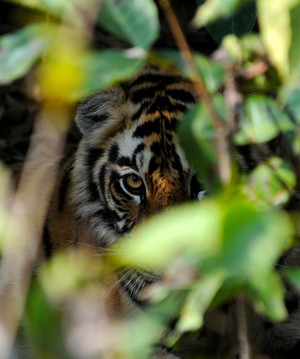All animals are equal, but some are more equal than others*: A review of carnivore research in India (1947-2020)
Paper titled ‘Chasms in charismatic species Research: Seventy years of carnivore science and its implications for conservation and policy in India’ that was recently published in the journal Biological Conservation, is a multi-institutional effort to review seventy years (1947-2020) of carnivore research in India. We reviewed a total of 1,792 published studies (of this 80 percent, i.e. 1,442 were journal articles) on carnivores found in India.

We found that most studies were conducted exclusively inside Protected Areas (PAs) (45 percent), while 24 percent were conducted outside PAs, whereas the remaining were conducted in both inside and outside PAs. A majority of studies were conducted on Felids, followed by Canids, Viverrids, and Mustelids as compared to other groups. The Bengal tiger Panthera tigris was the most studied species, as nearly 25 percent of all studies were on the species. This was followed by the common leopard Panthera pardus, golden jackal Canis aureus, dhole Cuon alpinus, and jungle cat Felis chaus.
We also found that collaborative studies between Indian and non-Indian institutions were generally published in higher impact factor journals. The number of publications were biased towards larger carnivores, especially species that were threatened and have expansive ranges. However, qualitatively, more studies did not mean more ecological information as many papers simply talked about carnivore distribution records from new localities. In terms of themes, natural history studies saw a steady decline over the decades, and most studies in the recent times were based on singular themes (e.g. diet, population ecology, behaviour).
Scientific knowledge contributed to litigation and formation of conservation policies for mostly large felids, the tiger being the most prominent. Common leopards and snow leopards Panthera uncia were other felids for which national guidelines or trans-national policies have been put in place. Startlingly however, many habitats for neglected carnivores are severely threatened but still categorised as wastelands in India. For example, habitats of the Indian wolf Canis lupus pallipes.
Among Indian funding agencies, the government was on the top of the list as far as supporting carnivore studies is concerned. International monies from zoos, foundations and other agencies focused on carnivore studies compared to other life forms including plants.
Implications and way ahead
- Data sharing through open-source platforms can bring transparency in carnivore research.
- Carnivore researchers should avoid publishing studies in potentially predatory (bogus) journals.
- True inter-disciplinary research can add value to carnivore management, but examples of multi-disciplinary research are rare in India.
- Research permissions are a major roadblock to democratising carnivore science in India, restricting access to non-governmental bodies and needs reform.
- Local stakeholders can also be more meaningfully involved through partnerships in long-term research programmes.
- Large-scale collaborations between government and non-government agencies/ local stakeholders in long-term research of carnivores is sparse in India and is the way ahead in synergising carnivore conservation efforts across the country.
*quote taken from the novel Animal Farm by George Orwell
About the author: Girish Punjabi is a Wildlife Biologist with WCT and is one of the authors on the study.
Disclaimer: The author is associated with Wildlife Conservation Trust. The views and opinions expressed in the article are his own and do not necessarily reflect the views and opinions of Wildlife Conservation Trust.
Your donations support our on-ground operations, helping us meet our conservation goals.
Related Links
- WCT’s Annual Review Meet 2022 Held at Pachmarhi
- Securing the Sahyadri-Konkan Corridor
- Monitoring Tigers Beyond Tiger Reserves
- Tiger Estimation outside PAs in Maharashtra
- 2016 wins the race for – “The Hottest Year on Record”
- 15-member panel to monitor wildlife plan implementation
